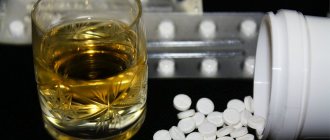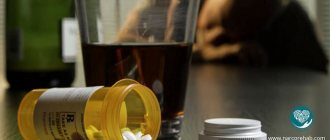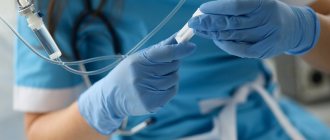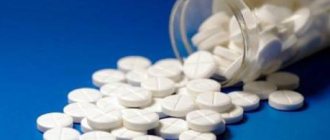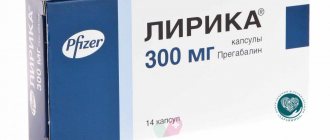Anonymously
Around the clock
Attention! The material contains information about substances, the use of which can cause serious harm to your health!
The use of medications to achieve a narcotic effect has gained wide popularity among addicts of all age categories. Long-term use of Promedol and other narcotic analgesics leads to the development of severe addiction, which destroys physical and mental health. Read more about the specifics of promedol addiction below.
- Narcotic drug Promedol
- What is Promedol?
- Composition of Promedol
- The effect of Promedol
- Duration of action and side effects
- The danger of Promedol
- Signs of using Promedol
- What is Promedol used for?
- How long does Promedol leave the body?
- How long does it stay in the blood?
- How long does it stay in urine?
- Consequences of using Promedol
- Overdose of Promedol
- Dependence on Promedol and treatment methods
We will select an individual treatment plan
Free consultation 8-800-200-27-23
Narcotic drug Promedol
Promedol is a drug that is actively used in medicine to relieve severe pain syndromes. In some cases, people suffering from drug addiction use Tramadol to relieve severe withdrawal symptoms. Attempts to relieve withdrawal lead to a “mutation” of addiction: over time, a craving for the drug develops.
What is Promedol/Trimeperidine?
Promedol (trimeperidine) is an opioid analgesic that is used to relieve severe pain syndromes. The drug has the following mechanisms of action:
- Changes in the nature of transmission of nerve impulses;
- Effect on higher parts of the brain;
- Slowing down of central nervous system functions.
Indications for the drug include pain relief after surgery, as a result of the development of oncology, as well as during childbirth. It is believed that a single use of the medication does not cause harm to the mother and child, but systematic recreational use leads to the development of severe pathologies.
HOW TO MOTIVATE A DEPENDENT FOR TREATMENT
Composition of Promedol
The drug contains trimeperidine. The substance is available in the form of an injection solution, tablets and syringe tube. This means that if tablets and ampoules of a medication are found in the belongings of a loved one, it makes sense to talk about a possible problem.
The effect of Promedol
The action of the analgesic is similar to morphine: as a result of its effect on opioid receptors, pain sensations recede very quickly. A short-term euphoria occurs and drug intoxication occurs.
REHABILITATION
Duration of action and side effects
The therapeutic effect occurs 20-30 minutes after application and lasts for 3-4 hours. According to the instructions, long-term use of the drug is strictly contraindicated due to serious side effects:
- The onset of severe withdrawal symptoms with abrupt withdrawal;
- Development of addiction;
- Convulsive attacks;
- Dizziness;
- Hallucinations;
- Depression;
- Migraine, etc.
As a result of the risk of severe adverse reactions, the use of the drug is carried out under the supervision of a physician. In addition, before prescribing, the doctor studies the list of contraindications and decides on the current dosage of the medication. Self-administration leads to severe pathologies and the development of addiction.
The danger of Promedol
The main danger of Promedol is the risk of severe dependence on the drug. Despite its use in medical practice, recreational use of Promedol leads to severe dependence. In addition, the development of tolerance leads to the need for a gradual increase in dosage. This results in overdose: respiratory depression, loss of consciousness, coma and death.
Find out treatment recommendations without leaving home for free
To select a treatment plan, you just need to leave a request, we will contact you to select the time and specialist you need
Submit your application
Formation of habituation
Most opiates act directly on endogenous mu receptors located in the brain structures responsible for emotions, pleasure and pain. Such a close relationship explains their ability to form dependence when used regularly. The potential for trimeperidine is moderate, lower than that of morphine and heroin.
The risk of opiate addiction for medical reasons is extremely low. It applies exclusively to patients with incurable diseases requiring palliative pain relief. In other cases, Promedol is used situationally or for a short course during a hospital stay for an emergency condition.
Pure dependence on trimeperidine is rather an exception to the rule. Addiction is typical for established drug addicts or susceptible individuals with a burdened psychoneurological history. Withdrawal syndrome develops gradually, but takes no more than a month.
Having accidentally lost Promedol, the patient faces the first somatovegetative symptoms of withdrawal. Typical signs of addiction appear: awareness of attraction to the substance, a state of discomfort and tension when not taking it. General health progressively worsens in the form of sleep disturbances, lacrimation, dilated pupils, chills, hot flashes, and weakness. Patients complain of the appearance of “goose bumps”, irresistible irritability and anxiety.
Withdrawal from narcotic analgesics is more severe than from heroin. Its severity is proportional to the duration of the addiction and the size of the dose taken.
Signs of using Promedol
Dramatic changes occur in the behavior and appearance of a drug addict, which must be monitored in a timely manner to provide assistance. Pay attention to these symptoms:
- Sharp weight loss;
- Pallor of the skin;
- The appearance of injection marks on the elbows (in case of heroin addiction with short-term use of Promedol, or injection of the drug);
- Constriction of the pupils, “glazing” of the gaze;
- Changes in behavior: inhibition of reactions, the appearance of unreasonable aggression;
- Hostility towards the previous environment, the desire to hide from people;
- Attempts to obtain a prescription to purchase the drug (without indications).
Often, scandals occur due to attempts to start a conversation with a drug addict about his problem. This means that in some situations it is necessary to contact a specialist for intervention.
Trimeperidine
International name of the medicinal substance:
Trimeperidine The list of drugs containing the active substance Trimeperidine is given after the description.
Pharmacological action:
An agonist of opioid receptors (mainly mu receptors), it has an analgesic (weaker and shorter than morphine), antishock, antispasmodic, uterotonic and mild hypnotic effect.
Activates the endogenous antinociceptive system and thus disrupts the interneuronal transmission of pain impulses at various levels of the central nervous system, and also changes the emotional coloring of pain. To a lesser extent than morphine, it depresses the respiratory center, and also stimulates the n.vagus centers and the vomiting center. It has an antispasmodic effect on the smooth muscles of internal organs (in spasmogenic effect it is inferior to morphine), promotes dilatation of the cervix during childbirth, increases tone and enhances myometrial contractions. With parenteral administration, the analgesic effect develops after 10-20 minutes, reaches a maximum after 40 minutes and lasts 2-4 hours or more (with epidural anesthesia - more than 8 hours). When taken orally, the analgesic effect is 1.5-2 times weaker than when administered parenterally. Pharmacokinetics:
Absorption is rapid with any route of administration. After oral administration, TCmax is 1-2 hours. After intravenous administration, a rapid decrease in plasma concentration is observed and after 2 hours only trace concentrations are determined. Communication with plasma proteins - 40%. Metabolized mainly in the liver by hydrolysis with the formation of meperidic and normeperidic acids, followed by conjugation. T1/2 - 2.4-4 hours, increases with renal failure. It is excreted in small quantities by the kidneys (including 5% unchanged).
Indications:
Pain syndrome (strong and moderate intensity): postoperative pain, unstable angina, myocardial infarction, dissecting aortic aneurysm, renal artery thrombosis, thromboembolism of the arteries of the extremities and pulmonary artery, acute pericarditis, air embolism, pulmonary infarction, acute pleurisy, spontaneous pneumothorax, peptic ulcer of the stomach and duodenum, perforation of the esophagus, chronic pancreatitis, hepatic and renal colic, paranephritis, acute dysuria, foreign bodies of the bladder, rectum, urethra, paraphimosis, priapism, acute prostatitis, acute attack of glaucoma, causalgia, acute neuritis, lumbosacral radiculitis, acute vesiculitis, thalamic syndrome, burns, pain in cancer patients, trauma, intervertebral disc protrusion, postoperative period.
Childbirth (pain relief for women in labor and stimulation). Acute left ventricular failure, pulmonary edema, cardiogenic shock. Preparation for surgery (premedication), if necessary - as an analgesic component of general anesthesia. Neuroleptanalgesia (in combination with antipsychotics). Contraindications:
Hypersensitivity, depression of the respiratory center;
with epidural and spinal anesthesia - impaired blood clotting (including during anticoagulant therapy), infection (risk of infection entering the central nervous system); diarrhea against the background of pseudomembranous colitis caused by cephalosporins, lincosamides, penicillins, toxic dyspepsia (delayed elimination of toxins and associated exacerbation and prolongation of diarrhea); simultaneous treatment with MAO inhibitors (including within 21 days after their use). Caution. Abdominal pain of unknown etiology, surgical interventions on the gastrointestinal tract, urinary system, bronchial asthma, COPD, convulsions, arrhythmias, arterial hypertension, CHF, respiratory failure, hepatic and/or renal failure, myxedema, hypothyroidism, adrenal insufficiency, central nervous system depression, intracranial hypertension , TBI, prostatic hyperplasia, suicidality, emotional lability, drug addiction (including history), severe inflammatory bowel diseases, urethral strictures, alcoholism, seriously ill, debilitated patients, cachexia, pregnancy, lactation, old age , childhood. Side effects:
From the digestive system: more often - constipation, nausea and/or vomiting;
less often - dry mouth, anorexia, spasm of the biliary tract, gastrointestinal irritation; rarely - with inflammatory bowel diseases - paralytic intestinal obstruction and toxic megacolon (constipation, flatulence, nausea, stomach cramps, gastralgia, vomiting); frequency unknown - hepatotoxicity (dark urine, pale stools, icterus of the sclera and skin). From the nervous system and sensory organs: more often - dizziness, weakness, drowsiness; less often - headache, blurred vision, diplopia, tremor, involuntary muscle twitching, euphoria, discomfort, nervousness, fatigue, nightmares, unusual dreams, restless sleep, confusion, convulsions; rarely - hallucinations, depression, in children - paradoxical agitation, anxiety; frequency unknown - convulsions, muscle rigidity (especially respiratory muscles), ringing in the ears; frequency unknown - slowing of the speed of psychomotor reactions, euphoria, disorientation. From the respiratory system: less often - depression of the respiratory center. From the cardiovascular system: more often - decreased blood pressure; less often - arrhythmias; frequency unknown - increased blood pressure. From the urinary system: less often - decreased diuresis, spasm of the ureters (difficulty and pain when urinating, frequent urge to urinate). Allergic reactions: less often - bronchospasm, laryngospasm, angioedema; rarely - skin rash, itching, swelling of the face, Local reactions: hyperemia, swelling, burning at the injection site. Other: less often - increased sweating; frequency unknown - addiction, drug dependence. Overdose. Symptoms of acute and chronic overdose: nausea, vomiting, cold sticky sweat, confusion, dizziness, drowsiness, decreased blood pressure, nervousness, fatigue, bradycardia, severe weakness, slow labored breathing, hypothermia, anxiety, miosis (with severe hypoxia, the pupils may be dilated ), convulsions, hypoventilation, cardiovascular failure, in severe cases - loss of consciousness, respiratory arrest, coma. Treatment: gastric lavage, maintaining sufficient pulmonary ventilation, systemic hemodynamics, normal body temperature. Patients should be under continuous monitoring; if necessary, perform mechanical ventilation, breathing stimulants; use of a specific opioid antagonist - naloxone. Interaction:
Strengthens the depressive effect and respiratory depression of narcotic analgesics, sedatives, hypnotics, antipsychotic drugs (neuroleptics), anxiolytics, drugs for general anesthesia, ethanol, muscle relaxants.
Against the background of systematic use of barbiturates, especially phenobarbital, a decrease in the analgesic effect is possible. Strengthens the hypotensive effect of drugs that lower blood pressure (including ganglion blockers, diuretics). Drugs with anticholinergic activity, antidiarrheal drugs (including loperamide) increase the risk of constipation, including intestinal obstruction, urinary retention and central nervous system depression. Enhances the effect of anticoagulants (plasma prothrombin should be monitored). Buprenorphine (including previous therapy) reduces the effect of other opioid analgesics; against the background of the use of high doses of mu-opioid receptor agonists, it reduces respiratory depression, and against the background of the use of low doses of mu- or kappa-opioid receptor agonists, it increases; accelerates the onset of symptoms when taking mu-opioid receptor agonists is stopped due to drug dependence, and when they are suddenly discontinued, it partially reduces the severity of these symptoms. When used simultaneously with MAO inhibitors, severe reactions may develop due to possible overexcitation or inhibition of the central nervous system with the occurrence of hyper- or hypotensive crises (should not be prescribed while taking MAO inhibitors, as well as within 14-21 days after stopping their use). Naloxone restores breathing, eliminates analgesia after the use of morphine, reduces the effect of opioid analgesics, as well as the respiratory depression and central nervous system caused by them; Large doses may be required to neutralize the effects of butorphanol, nalbuphine and pentazocine, which were prescribed to eliminate the undesirable effects of other opioids; may accelerate the onset of symptoms associated with drug addiction. Naltrexone accelerates the appearance of symptoms against the background of drug addiction (symptoms can appear as early as 5 minutes after administration of the drug, last for 48 hours, and are characterized by persistence and difficulty in eliminating them); reduces the effect of opioid analgesics (analgesic, antidiarrheal, antitussive); does not affect symptoms caused by histamine reaction. Reduces the effect of metoclopramide. Special instructions:
During the treatment period, it is necessary to refrain from driving vehicles and engaging in other potentially hazardous activities that require increased concentration and speed of psychomotor reactions, and avoid consuming ethanol.
Preparations containing the active ingredient Trimeperidine:
Promedol
The information provided in this section is intended for medical and pharmaceutical professionals and should not be used for self-medication. The information is provided for informational purposes only and cannot be considered official.
What is Promedol used for?
Promedol and its analogues are used to relieve severe pain. Drug addicts acquire the drug illegally in order to “bring down” withdrawal symptoms. The drug is used as a temporary replacement for heroin, but over time it only worsens opioid addiction.
In some situations, recreational use occurs for the purpose of “experimenting” with health. Curiosity leads to the development of severe damage to internal organs, mental illness and drug addiction.
Use of the drug Trimeperidine
S/c, i/m, i/v. For adults, 1 ml of 1 or 2% solution is administered subcutaneously; for intense pain, especially with malignant tumors and severe injuries - up to 2 ml of 2% solution. To relieve labor pain, a dose of 1–2 ml of 2% solution is administered subcutaneously when the cervical pharynx is dilated by one and a half to two fingers and at normal heart rhythm and fetal heart rate. If necessary, trimeperidine is administered again after 2-3 hours. As the main component of premedication - subcutaneously or intramuscularly at a dose of 0.02-0.03 g (1-1.5 ml of 2% solution) together with atropine sulfate in a dose of 0.0005 g (0.5 mg) 30–45 minutes before surgery (for emergency premedication, IV is used). In the absence of breathing problems in the postoperative period, 1 ml of 1 or 2% solution is administered subcutaneously as an analgesic and anti-shock agent. Higher doses subcutaneously: single - 0.04 g, daily - 0.16 g. Children over 2 years old and depending on age - 0.003–0.01 g.
Events
08.11.21
Residents' trip to the Zvenigorod club "Goliath"
Leisure activities are an integral part of the rehabilitation program for residents. Team games, visiting museums, theaters, exhibitions, picnics...Read more (~2 min.)
«
13.10.21
Travel of rehabilitators of the “Zdravnitsa” Center to “Ruzskaya Alaska”
One of the important tasks of a rehabilitation center for addicted people is to teach them to enjoy life in sobriety, to find...Read more (~2 min.)
«
21.09.21
Guests from the Moscow Regional Duma in
In September, a delegation of candidates for deputies of the Moscow Regional Duma, the head of the election headquarters of the Rodina party, visited. [zdravnews] Employees...Read more (~1 min.)
«
31.08.21
How does the socialization of addicts proceed?
Social adaptation (Resocialization and Outpatient Clinic) is one of the stages of rehabilitation. Characterized by the return or strengthening of social ties, the elimination of manifestations of social...Read more (~2 min.)
«
All events
How long does Promedol leave the body?
To quickly remove trimeperidine metabolites from the body, it is necessary to know how long the drug is retained in the blood and urine. Timely detoxification accelerates the removal of the drug from organs and tissues. The duration of elimination of a substance from the body is influenced by the following factors:
- Time of last use;
- Frequency of application;
- The presence of chronic diseases (diseases of the liver, kidneys and endocrine system affect the metabolic rate);
- Features of the weight of a drug addict. In people with a low percentage of subcutaneous fat, Promedol metabolites are eliminated faster;
- Specifics of physical activity: physical inactivity leads to a slowdown in metabolic processes.
DETOXIFICATION FOR DRUG ADDICTION
How long does it stay in the blood?
The maximum concentration of Promedol in the blood remains for three to four hours. As a result of the effect on blood components, a change in its structure is possible, which significantly prolongs the consequences of using the drug.
How long does it stay in urine?
The half-life of Promedol through the kidneys occurs within four hours, however, in the presence of renal pathologies, this figure increases.
Overdose of Promedol
During an overdose, the following symptoms are observed:
- Panic attacks;
- Respiratory depression;
- Reduced blood pressure;
- Decrease in temperature;
- Confusion and loss of consciousness;
- Hypoxia;
- Nausea, vomiting, etc.
If an overdose occurs, you must call an ambulance: otherwise there is a risk of death.
REMOVAL AT HOME


